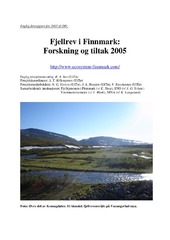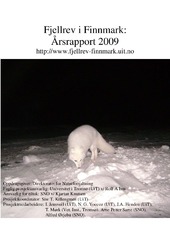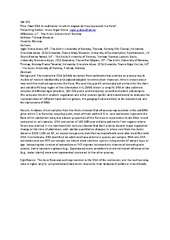Blar i forfatter "Yoccoz, Nigel Gilles"
-
Fjellrev i Finnmark : forskning og tiltak 2005
Skog, E.; Ims, Rolf Anker; Killengreen, Siw Turid; Scheie, J. O.; Mørk, T.; Yoccoz, Nigel Gilles; Henden, John-André; Langeland, K.; Ravolainen, Virve (Research report; Forskningsrapport, 2005) -
Fjellrev i Finnmark : forskning og tiltak 2006
Knutsen, Kjartan; Ims, Rolf Anker; Mørk, T.; Killengreen, Siw Turid; Langeland, K.; Yoccoz, Nigel Gilles; Henden, John-André; Ravolainen, Virve (Research report; Forskningsrapport, 2006) -
Fjellrev i Finnmark: Årsrapport 2009
Ims, Rolf Anker; Mørk, Torill; Sarre, Arne Petter; Killengreen, Siw Turid; Knutsen, Kjartan; Jensvoll, Ingrid; Yoccoz, Nigel Gilles; Ørjebu, Alfred; Henden, John-André (Research report; Forskningsrapport, 2009) -
Gatekeepers to the effects of climate warming? Niche construction restricts plant community changes along a temperature gradient
Bråthen, Kari Anne; Gonzalez, Victoria; Yoccoz, Nigel Gilles (Journal article; Tidsskriftartikkel; Peer reviewed, 2017-06-20)Organisms that modify the environment (niche constructors) are likely candidates to mediate the effects of climate warming. Here we assess tundra plant community changes along a temperature gradient and how these are modified in the presence of the common allelopathic dwarf shrub Empetrum nigrum and the large herbivore Rangifer tarandus. 2 We developed a structural equation model based on data ... -
Highly overlapping winter diet in two sympatric lemming species revealed by DNA metabarcoding
Soininen, Eeva M; Gauthier, Gilles; Bilodeau, Frederic; Berteaux, Dominique; Gielly, Ludovic; Taberlet, Pierre; Gussarova, Galina; Bellemain, Eva; Hassel, Kristian; Stenøien, Hans K.; Epp, Laura; Schrøder-Nielsen, Audun; Brochmann, Christian; Yoccoz, Nigel Gilles (Journal article; Tidsskriftartikkel; Peer reviewed, 2015-01-30)Sympatric species are expected to minimize competition by partitioning resources, especially when these are limited. Herbivores inhabiting the High Arctic in winter are a prime example of a situation where food availability is anticipated to be low, and thus reduced diet overlap is expected. We present here the first assessment of diet overlap of high arctic lemmings during winter based on DNA ... -
Identifying key needs for the integration of social-ecological outcomes in arctic wildlife monitoring
Wheeler, Helen Claire; Berteaux, Dominique; Furgal, Chris; Cazelles, Kevin; Yoccoz, Nigel Gilles; Grémillet, David (Journal article; Tidsskriftartikkel; Peer reviewed, 2018-11-24)For effective monitoring in social–ecological systems to meet needs for biodiversity, science, and humans, desired outcomes must be clearly defined and routes from direct to derived outcomes understood. The Arctic is undergoing rapid climatic, ecological, social, and economic changes and requires effective wildlife monitoring to meet diverse stakeholder needs. To identify stakeholder priorities ... -
Long-term environmental monitoring for assessment of change: measurement inconsistencies over time and potential solutions
Ellingsen, Kari Elsa; Yoccoz, Nigel Gilles; Tveraa, Torkild; Hewitt, Judi E.; Thrush, Simon F. (Journal article; Tidsskriftartikkel; Peer reviewed, 2017-10-30)The importance of long-term environmental monitoring and research for detecting and understanding changes in ecosystems and human impacts on natural systems is widely acknowledged. Over the last decades, a number of critical components for successful long-term monitoring have been identified. One basic component is quality assurance/quality control protocols to ensure consistency and comparability ... -
Modelled drift patterns of fish larvae link coastal morphology to seabird colony distribution
Sandvik, Hanno; Barrett, Robert T.; Erikstad, Kjell E; Myksvoll, Mari Skuggedal; Vikebø, Frode Bendiksen; Yoccoz, Nigel Gilles; Anker-Nilssen, Tycho; Lorentsen, Svein-Håkon; Reiertsen, Tone; Skardhamar, Jofrid; Skern-Mauritzen, Mette; Systad, Geir Helge (Journal article; Tidsskriftartikkel; Peer reviewed, 2016-05-13)Colonial breeding is an evolutionary puzzle, as the benefits of breeding in high densities are still not fully explained. Although the dynamics of existing colonies are increasingly understood, few studies have addressed the initial formation of colonies, and empirical tests are rare. Using a high-resolution larval drift model, we here document that the distribution of seabird colonies along the ... -
Not only mosses: lemming winter diets as described by DNA metabarcoding
Soininen, Eeva M; Zinger, Lucie; Gielly, Ludovic; Yoccoz, Nigel Gilles; Henden, John-André; Ims, Rolf Anker (Journal article; Tidsskriftartikkel; Peer reviewed, 2017-04-01)The temporal dynamics of most tundra food webs are shaped by the cyclic population dynamics of lemmings. While processes during winter may be behind the recent disruptions of lemming cycles, lemming winter ecology is poorly known. We present here the first DNA metabarcoding data on the winter diet of Norwegian lemmings (Lemmus lemmus), based on feces collected after a winter of population ... -
Phenology and cover of plant growth forms predict herbivore habitat selection in a high latitude ecosystem
Iversen, Marianne; Fauchald, Per; Langeland, Knut; Ims, Rolf Anker; Yoccoz, Nigel Gilles; Bråthen, Kari Anne (Journal article; Tidsskriftartikkel; Peer reviewed, 2014)The spatial and temporal distribution of forage quality is among the most central factors affecting herbivore habitat selection. Yet, for high latitude areas, forage quantity has been found to be more important than quality. Studies on large ungulate foraging patterns are faced with methodological challenges in both assessing animal movements at the scale of forage distribution, and in assessing ... -
Plant DNA in sediments: to which degree do they represent the flora?
Alsos, Inger Greve; Coissac, Eric; Edwards, Mary E.; Merkel, Marie Kristine Føreid; Gielly, Ludovic; Sjögren, Per; Taberlet, Pierre; Yoccoz, Nigel Gilles (Conference object; Konferansebidrag, 2015-05) -
Plant DNA metabarcoding of lake sediments: How does it represent the contemporary vegetation
Alsos, Inger Greve; Lammers, Youri; Yoccoz, Nigel Gilles; Jørgensen, Tina; Sjögren, Per; Gielly, Ludovic; Edwards, Mary E. (Journal article; Tidsskriftartikkel; Peer reviewed, 2018-04-17)Metabarcoding of lake sediments have been shown to reveal current and past biodiversity, but little is known about the degree to which taxa growing in the vegetation are represented in environmental DNA (eDNA) records. We analysed composition of lake and catchment vegetation and vascular plant eDNA at 11 lakes in northern Norway. Out of 489 records of taxa growing within 2 m from the lake shore, ... -
Populasjonssykluser hos hare – drevet av rovdyr og spesielt gaupe
Ehrich, Dorothee; Yoccoz, Nigel Gilles (Journal article; Tidsskriftartikkel; Peer reviewed, 2019-06-27)Snøskohare – og gaupesyklusene i det boreale Nord-Amerika er et av de best kjente eksempler på populasjonssykluser. Sammenlignet med andre sykliske arter har denne syklusen en relativ konstant periode på 9–10 år. Haretettheten varierer typisk 20–30 ganger mellom topp- og bunnår. Mye økologisk forskning har ved hjelp av forskjellige metoder forsøkt å avdekke årsakene til snøskoharesyklusene, også med ... -
Prey density in non-breeding areas affects adult survival of black-legged kittiwakes Rissa tridactyla
Reiertsen, Tone K.; Erikstad, Kjell E.; Anker-Nilssen, Tycho; Barrett, Robert T.; Boulinier, Thierry; Frederiksen, Morten; González-Solís, Jacob; Grémillet, David; Johns, David; Moe, Børge; Ponchon, Aurore; Skern-Mauritzen, Mette; Sandvik, Hanno; Yoccoz, Nigel Gilles (Journal article; Tidsskriftartikkel; Peer reviewed, 2014-08-27)In migratory birds, environmental conditions in both breeding and non-breeding areas may affect adult survival rates and hence be significant drivers of demographic processes. In seabirds, poor knowledge of their true distribution outside the breeding season, however, has severely limited such studies. This study explored how annual adult survival rates of black-legged kittiwakes Rissa tridactyla ... -
A probabilistic algorithm to process geolocation data
Merkel, Benjamin; Phillips, Richard A.; Descamps, Sébastien; Yoccoz, Nigel Gilles; Moe, Børge; Strøm, Hallvard (Journal article; Tidsskriftartikkel; Peer reviewed, 2016-11-18)<p><i>Background: </i>The use of light level loggers (geolocators) to understand movements and distributions in terrestrial and marine vertebrates, particularly during the non-breeding period, has increased dramatically in recent years. However, inferring positions from light data is not straightforward, often relies on assumptions that are difficult to test, or includes an element of subjectivity ... -
Prosjekt ”Fjellrev i Finnmark” : rapport for perioden 2004-2007
Ims, Rolf Anker; Killengreen, Siw Turid; Henden, John-André; Yoccoz, Nigel Gilles (Research report; Forskningsrapport, 2007) -
Quantifying individual heterogeneity and its influence on life-history trajectories: different methods for different questions and contexts
Hamel, Sandra; Gaillard, Jean-Michel; Douhard, Mathieu; Festa-Bianchet, Marco; Pelletier, Fanie; Yoccoz, Nigel Gilles (Journal article; Tidsskriftartikkel; Peer reviewed, 2017-09-25)Heterogeneity among individuals influences the life‐history trajectories we observe at the population level because viability selection, selective immigration and emigration processes, and ontogeny change the proportion of individuals with specific trait values with increasing age. Here, we review the two main approaches that have been proposed to account for these processes in life‐history trajectories, ... -
Raising offspring increases ageing: Differences in senescence among three populations of a long-lived seabird, the Atlantic puffin
Landsem, Terje Lorentzen; Yoccoz, Nigel Gilles; Layton-Matthews, Kate; Hilde, Christoffer Høyvik; Harris, Michael P; Wanless, Sarah; Daunt, Francis; Reiertsen, Tone Kristin; Erikstad, Kjell E.; Anker-Nilssen, Tycho (Journal article; Tidsskriftartikkel; Peer reviewed, 2023-01-12)1. Actuarial senescence, the decline of survival with age, is well documented in the wild. Rates of senescence vary widely between taxa, to some extent also between sexes, with the fastest life histories showing the highest rates of senescence. Few studies have investigated differences in senescence among populations of the same species, although such variation is expected from population-level ... -
The role of a dominant predator in shaping biodiversity over space and time in a marine ecosystem
Ellingsen, Kari Elsa; Anderson, Marti J.; Shackell, Nancy L.; Tveraa, Torkild; Yoccoz, Nigel Gilles; Frank, Kenneth T. (Journal article; Tidsskriftartikkel; Peer reviewed, 2015-06-24)Exploitation of living marine resources has resulted in major changes to populations of targeted species and functional groups of large-bodied species in the ocean. However, the effects of overfishing and collapse of large top predators on the broad-scale biodiversity of oceanic ecosystems remain largely unexplored. Populations of the Atlantic cod (Gadus morhua) were overfished and several collapsed ... -
The role of predation and food limitation on claims for compensation, reindeer demography and population dynamics
Tveraa, Torkild; Stien, Audun; Brøseth, Henrik; Yoccoz, Nigel Gilles (Journal article; Tidsskriftartikkel; Peer reviewed, 2014-10)1.A major challenge in biodiversity conservation is to facilitate viable populations of large apex predators in ecosystems where they were recently driven to ecological extinction due to resource conflict with humans. 2. Monetary compensation for losses of livestock due to predation is currently a key instrument to encourage human–carnivore coexistence. However, a lack of quantitative estimates ...


 English
English norsk
norsk


















